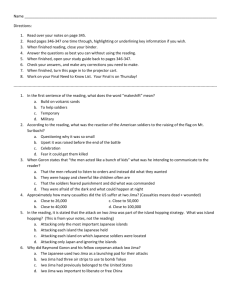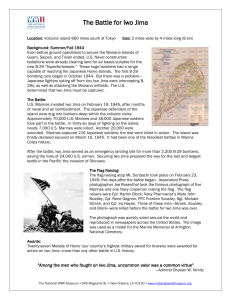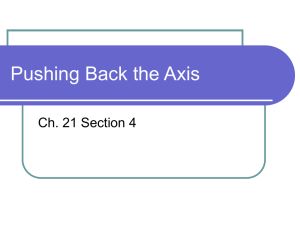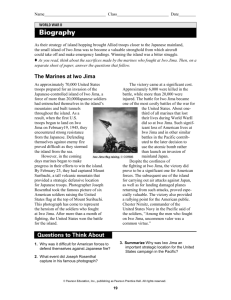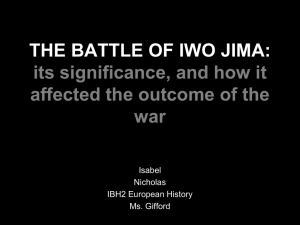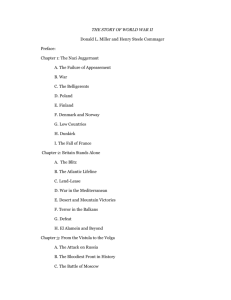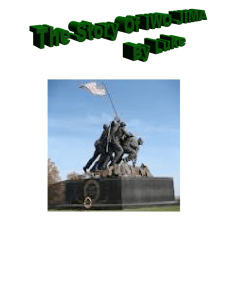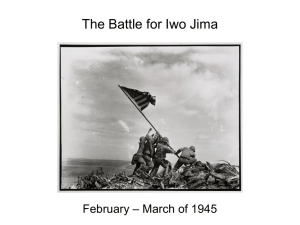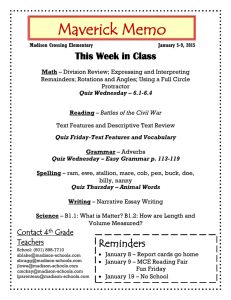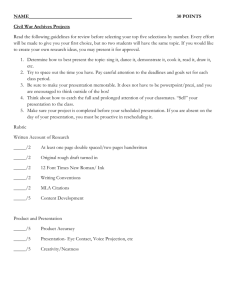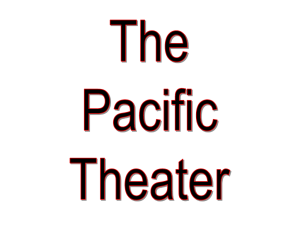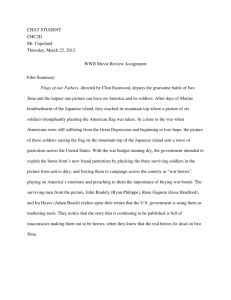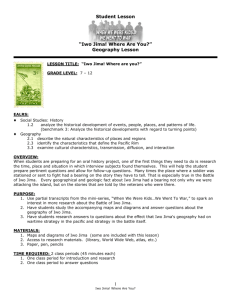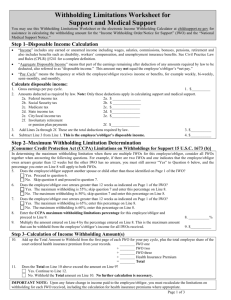Sample Outline #2 - Prussing Elementary School
advertisement
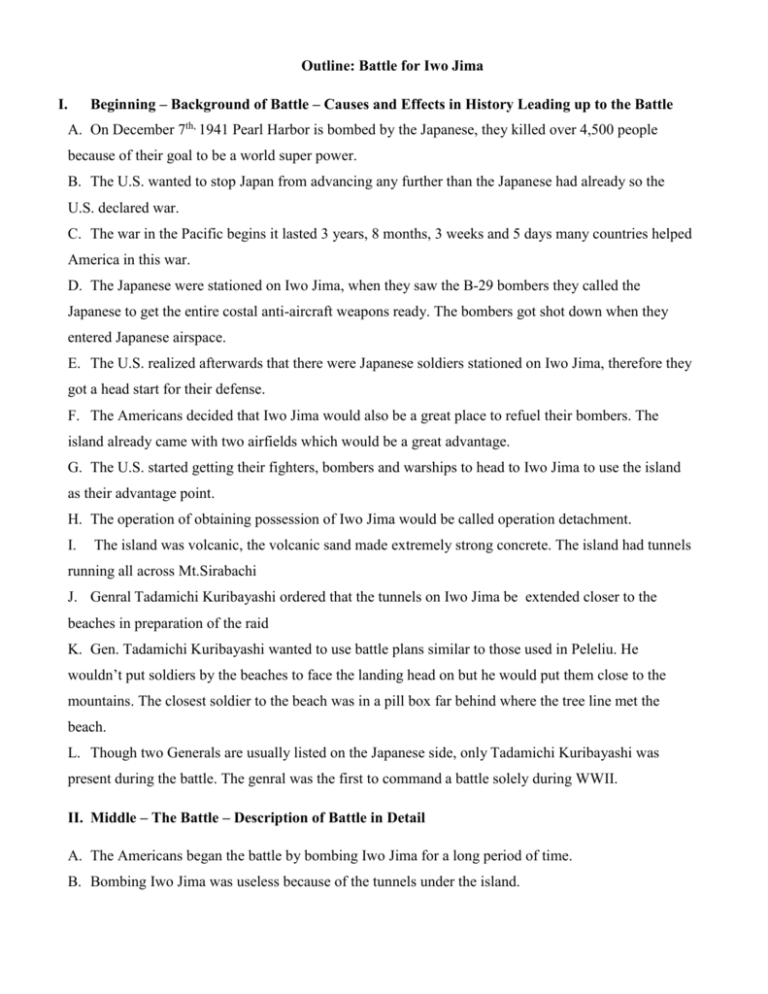
Outline: Battle for Iwo Jima Beginning – Background of Battle – Causes and Effects in History Leading up to the Battle I. A. On December 7th, 1941 Pearl Harbor is bombed by the Japanese, they killed over 4,500 people because of their goal to be a world super power. B. The U.S. wanted to stop Japan from advancing any further than the Japanese had already so the U.S. declared war. C. The war in the Pacific begins it lasted 3 years, 8 months, 3 weeks and 5 days many countries helped America in this war. D. The Japanese were stationed on Iwo Jima, when they saw the B-29 bombers they called the Japanese to get the entire costal anti-aircraft weapons ready. The bombers got shot down when they entered Japanese airspace. E. The U.S. realized afterwards that there were Japanese soldiers stationed on Iwo Jima, therefore they got a head start for their defense. F. The Americans decided that Iwo Jima would also be a great place to refuel their bombers. The island already came with two airfields which would be a great advantage. G. The U.S. started getting their fighters, bombers and warships to head to Iwo Jima to use the island as their advantage point. H. The operation of obtaining possession of Iwo Jima would be called operation detachment. I. The island was volcanic, the volcanic sand made extremely strong concrete. The island had tunnels running all across Mt.Sirabachi J. Genral Tadamichi Kuribayashi ordered that the tunnels on Iwo Jima be extended closer to the beaches in preparation of the raid K. Gen. Tadamichi Kuribayashi wanted to use battle plans similar to those used in Peleliu. He wouldn’t put soldiers by the beaches to face the landing head on but he would put them close to the mountains. The closest soldier to the beach was in a pill box far behind where the tree line met the beach. L. Though two Generals are usually listed on the Japanese side, only Tadamichi Kuribayashi was present during the battle. The genral was the first to command a battle solely during WWII. II. Middle – The Battle – Description of Battle in Detail A. The Americans began the battle by bombing Iwo Jima for a long period of time. B. Bombing Iwo Jima was useless because of the tunnels under the island. C. Japanese soldiers on Iwo Jima were made promise, that before they shed their own lives they must kill at least 10 American soldiers. D. When the Americans first landed in Iwo Jima the soldiers were unarmed and had no supplies. E. The Japanese were waiting in pill boxes far from the beaches. Pill boxes are small concrete rooms with a small window missing but are filled with cannons, machine guns, Etc. these are great forms of protection. F. The Japaneese would fire mortars at the amphibious landing vehicles. Some vehicles would explode and block reinforcements from reaching the island; some vehicles would stay intact but with few soldiers to protect them. G. The U.S. marines suffered many casualties when they hit the beaches. Many had to lie in the sand and wait for reinforcements. H. The amphibious landing on Iwo Jima was part of the D-day operation, not to be confused with the European D-day. The D-day in the pacific was not as well-known but was just as important because it began raids on many islands near Japan, including Iwo Jima. I. The U.S. reinforcements got to the beach after the unarmed marines were desperately waiting on the beach, taking high casualty rates. J. The U.S. Marines were joyous to be able to help their fallen comrades. Most of the American weapons were delivered to the island via Amtrak’s. (amphibious landing vehicles that had tracks as wheels and were known as amphibious tractors) K. During the battle the Japaneese were not confident that they would defeat the Americans. Their plan was to change American plans for their raid planed for V - E Day (Victory in Europe day). L. Though the Japaneese were not confident, they put on their A-game. The Japaneese soldiers would fire a few times and would stand back, shutting a steel door in front of them. This made it hard for Americans to flush out the Japaneese their best bet was to use the, M2-A1 flame thrower. M. A flamethrower is a weapon that contains tanks of flammable gas or liquid they shot out this gas or liquid ignited and are used as very powerful weapon. N. Often the men manning flame throwers were put in the most danger because the weapons had a very short range, witch meant close combat. Sometimes the U.S. soldiers would have to wait for the Japaneese solders to open their hatches before they could flush them out. O. Flame throwers were very bright this issue made the men manning flame throwers easy targets for snipers. P. The Americans were in control of the air space around Iwo Jima from the beginning of the battle. The most used aircraft was the P-51 Mustang. Q. Airplanes offered little help to the Americans. Japanese soldiers would hide in their concrete pill boxes, and bullets from aircraft could not penetrate them. R. On February 23rd 1945 the Americans took control of Mt.Sirabachi above ground. A few solders raised a small flag atop the MT. Later that day four soldiers raised a larger flag on the MT. this is when the famous picture was taken by Joe Rosenthal, this picture is one of the most recognized pictures of WWII. S. The flag rising was very deceptive to many soldiers. Some thought that the battle was over, and that they won, but the battle wasn’t over yet T. Some of the American generals got together and decided that the flame thrower was the most effective weapon in this battle, and it could be more effective on a tank so they created a flame thrower tank. Their idea miserably failed because the tank took a long time to move in close parameters. Also the tank was easily blown up with 50 caliber bullets easily due to the flammable gas inside. This would kill Americans in and around the tank. U. When the Americans captured the first airfield, an American speedy construction team called the Sea Bees repaved the air field so it could be used by U.S. aircraft during the battle. The Sea Bees started in WWII and were just civilian contractors, now they are known as one of the greatest army construction teams in the world. V. When the U.S. captured the second airfield the first crews on the field were mortified. The soldiers nicknamed the airfield the “Meat grinder”. The solders found body parts scattered across the field it took a while to begin the pavement of this field because some superstitious soldiers said that the field was haunted, some say it was because the sea bees had to finish the first airfield and that they weren’t scared. W. Though the air fields on Iwo Jima were under the command of the Americans many of the hills around it weren’t. Though the airfields were hard to use in these conditions the Americans thought if there’s a will there’s a way and the Americans did use the fields. The Americans did assign task forces to take care of the Japaneese in the mountains. X. Though there were many more Americans, the Japaneese technique was a lot better thought through. There were many hills that contained pill boxes that were very hard to penetrate; these boxes were in the possession of the Japaneese. Y. The U.S. always bombed first and then sent soldiers, so this time to penetrate the hills the U.S. soldiers went during the night, the Japaneese were easy to take because most were sleeping. (Americans almost never attacked during the night). Z. During the last part of the battle the Japaneese began their counter attack but they were unsuccessful due to they were used to a different type of battle (the type out of their pillboxes). AA. Though the Japaneese counter attack didn’t work they continued on attacking the American camps and eventually started penetrating the U.S. communications and headquarters. BB. The Japaneese were persistent and were not planning on giving up. The Japaneese fought until they had no more to fight they were not to give up CC. On March sixth the battle was over, the island was declared secure. Ending – Significance of Battle and Results after the Battle, both short and long-term. III. A. Of all the Japanese soldiers in Iwo Jima, 21,844 soldiers died from fighting and 216 were captured. B. From the American side 6,821 soldiers were KIA. Though two soldiers were captured they were later recovered. There were 19,217 U.S. soldiers wounded in the battle. C. From the U.S. Navy 18 ships were sunk in this battle. D. When the battle began, Tadamichi Kuribayashi the Japaneese genral told his soldiers that Americans were like animals and, that it was proper or right to kill them. When a few of the final Japanese troops left on the island surrendered they found that the genral lied to them because Americans were giving them cigars and coffee and other luxuries. E. After the battle many people said Iwo Jima just cost too much. We lost too many soldiers, and too much money for the island just to be used to refuel airplanes. But they didn’t know that Iwo Jima was going to be the last stop for an atom bomb on its way to Hiroshima. F. Iwo Jima was an important strategic island for two reasons. The U.S. could use the island for bombing missions, (dropping the atom bomb on Hiroshima) and for refueling their B-29 bombers. G. on August sixth a B-29 bomber called the “Enola Gay” escorted by 100 p-51`s flew to Hiroshima from Iwo Jima and dropped the first atom ever to be used for warfare. H. The atom bomb was called “little boy” because it was about the size of a little boy, yet it could cause so much damage. This bomb was part of the top secret Manhattan project. Once the bomb got delivered to Tinian it waited until Iwo Jima was under control. I. On September second 1945 the Japaneese surrendered and signed the official treaty. Ending the war. J. In 1968 the island of Iwo Jima was returned to the Japaneese, 28 years after the Japaneese surrendered. K. 1n 2007, 62 years after the Japaneese surrendered, Iwo Jima was renamed Iwo To.
